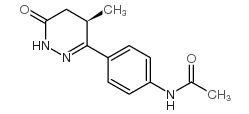220246-81-1
| Name | N-[4-[(4R)-4-methyl-6-oxo-4,5-dihydro-1H-pyridazin-3-yl]phenyl]acetamide |
|---|---|
| Synonyms |
(R)-N-[4-(1,4,5,6-Tetrahydro-4-methyl-6-oxo-3-pyridazinyl)phenyl]-acetamide
(R)-N-ACETYL-6-(4-AMINOPHENYL)-4,5-DIHYDRO-5-METHYL-3(2H)-PYRIDAZINONE OR-1896 dihydropyridazinone 6a |
| Description | OR-1896 is an active long-lived metabolite of Levosimendan. OR-1896 is a highly selective phosphodiesterase (PDE) III isoform inhibitor and a powerful vasodilator. OR-1896 can open ATP-sensitive K+ channels and has Ca2+-sensitizing effect. OR-1896 mitigates cardiomyocyte apoptosis, cardiac remodeling and myocardial inflammation[1]. |
|---|---|
| Related Catalog | |
| Target |
PDE3/PDE Ⅲ K+ Channel Drug Metabolite |
| In Vitro | There are many evidences has accumulated and revealed a variety of beneficial pleiotropic effects OR-1896. OR-1896 evokes prominent vasodilatory responses, activation of ATP-sensitive sarcolemmal K+ channels of smooth muscle cells appears as a powerful vasodilator mechanism. Additionally, activation of ATP-sensitive K+ channels in the mitochondria potentially extends the range of cellular actions towards the modulation of mitochondrial ATP production and implicates a pharmacological mechanism for cardioprotection[1]. |
| In Vivo | During the metabolism of Levosimendan approximately 5% of the drug is converted to the metabolite OR-1855 in the large intestine, and then acetylated in the liver to form the active metabolite OR-1896. Binding to plasma proteins is 98% for Levosimendan but only 40% for OR-1896. Unlike Levosimendan, which has an elimination half-life of 1-1.5 h, the half-life of OR-1896 is about 75 to 80 h allowing cardiovascular effects to persist up to 7 to 9 days after discontinuation of a 24-hour infusion of levosimendan. The pharmacokinetic of the parent drug is unaltered in subjects with severe renal impairment or with moderate hepatic impairment, whereas the elimination of its metabolites (OR-1896) can be prolonged[1]. |
| References |
| Density | 1.278 g/cm3 |
|---|---|
| Melting Point | 224-226ºC |
| Molecular Formula | C13H15N3O2 |
| Molecular Weight | 245.27700 |
| Exact Mass | 245.11600 |
| PSA | 70.56000 |
| LogP | 1.34250 |
| Storage condition | -20°C |
